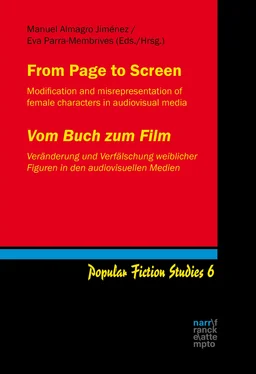1 ...6 7 8 10 11 12 ...27 The first Heidi animated TV series partly fits into the definition of transposition as established by Wagner “in which a novel is directly given on the screen, with the minimum of apparent interference” and in which the film is frequently “envisaged as a book illustration” (Wagner, 1975: 222). Transpositions re-tell in a different platform or genre the content of the story, but nonetheless preserve characterization of figures and the chronotope of the original text (cf. McCallum, 2018: 38). In this regard, the first twenty-five episodes of Takahata’s version closely follow both the plot and even parts of the dialogues of Spyri’s original and also retain the voice of a female narrator, who, as if she were Johanna Spyri herself, sides with the character of Heidi. Nonetheless, from the appearance of Clara’s grandmother in chapter 27, the animated version deviates remarkably from its hypotext: as mentioned before, the religious message conveyed by Clara’s grandmother is silenced and this female character is more intensely profiled in order to forge an educational counterpart to Rottenmeier and, most importantly for my research, the figure of Rottenmeier herself is granted more of a central role than in the novel, as will be shown in the analysis.
The more recent 3D version Heidi rather conforms to the idea of reversion, in which a film may seek to interrogate the values portrayed in the source text, and potentially update it or its adaptations (cf. McCallum, 2018: 20). In this regard, the dialogical (Bakhtin) dimension of the second animated series is thus far more evident. Heidi 3D , as noted above, enables a deeper exploration of the characters. The plot gains in importance, while several storylines aim to strengthen the bonds between the characters.
Among the child figures, for instance, Peter and Heidi are also confronted with a group of children in the village, in order to underline the goodness of those living higher up in the mountains – again strengthening the dichotomy between society and nature. Indeed, even if these children are depicted as selfish and as bullies, Peter and Heidi do not hesitate to offer help whenever they need it. With regard to Heidi’s grandfather, while the anime is very vague about his past, the 3D version – just like the original novel – more clearly addresses the presence of a “past”, from which he would like to escape: he feels guilty for the death of his only son, Heidi’s father, who died in an accident when they were working together. The 3D series also creates a completely new subplot with the love story between Aunt Dete – who in this version works as a maid and cook at the Sesemann’s house – and Sebastian, the butler, who not only keeps the vis comica he has in the novel and in the first animated version, but is also granted a more endearing character. All female figures are explored in more detail in the most recent series. The character of Aunt Dete, for example, is developed in a completely different way than in the anime or the novel, in which she appears to be a negative character, rough and selfish, who does not really care about Heidi’s needs but rather about her own financial survival, and is willing to let her fall victim to whatever destiny awaits her: “(W)enn Ihr’s nicht haben könnt, so macht mit ihm, was Ihr wollt, dann habt Ihr’s zu verantworten, wenn’s verdirbt, und Ihr werdet wohl nicht nötig haben, noch etwas aufzuladen” (Spyri, 1978: 11)2. Furthermore, both in the novel and the first animated version, she finds an excuse not to have to travel back to Switzerland with Heidi, when the child falls ill and the doctor advises her to return to the mountains (Spyri, 1978: 102). In contrast, her 3D version regrets having left her in the mountains, cares about the feelings of the child and always tries to act in her best interest. Although she still retains some of the original’s flaws, she is more far more caring and has lost the roughness in manners and behavior which define her anime predecessor. And, in the final episode, she is able to apologize to Heidi’s grandfather for having taken Heidi away from him (Nakajima, Takahata, 1974: episode 39). As regards Frau Sesemann, Clara’s grandmother, she would deserve a chapter of her own, since her transformation from the page to the screen is very revealing and ideologically loaded: in Spyri’s novels, she is, as has been noted before, the person responsible for “converting” Heidi by teaching her how to pray. In both animated versions, the religious content is silenced3, but Frau Sesemann is still a mentor for Heidi, since she not only teaches her how to read but also inspires in the child a love of reading and learning and thus becomes Rottenmeier’s pedagogical counterpart.
3.1 Characterization of the figure of Fräulein Rottenmeier in Spyri’s novels
The analysis of the figure of Rottenmeier will be conducted on the basis of both (a) linguistic and (b) audiovisual features. The literary characterization of Fräulein Rottenmeier in Spyri’s text will be examined by observing stylistic markers on three levels (as in Culpeper, 2001): what the narrator says about her, what other characters say or how they react around her, and her own utterances and behaviors.
The first description we read of this figure in Spyri’s novel, portrays her as a weighty and solemn being:
Die letztere saß sehr aufrecht an einem kleinen Arbeitstisch und stickte. Sie hatte eine geheimnisvolle Hülle um sich, einen großen Kragen oder Halbmantel, welcher der Persönlichkeit einen feierlichen Anstrich verlieh, der noch erhöht wurde durch eine Art von hochgebauter Kuppel , die sie auf dem Kopfe trug. Fräulein Rottenmeier war schon seit mehreren Jahren, seitdem die Dame des Hauses gestorben war, im Hause Sesemann, führte die Wirtschaft und hatte die Oberaufsicht über das ganze Dienstpersonal. (my italics, Spyri, 1978: 47–48)
This description of Rottenmeier as an imposing figure, who observes others from a distance with a good deal of arrogance and superiority is underlined not only in the narrative descriptions, but also through the utterances by Rottenmeier herself and by the characters who surround her. Her positioning on a higher plane, which reflects both her haughtiness and her lack of empathy, is evident from the first encounter: to present themselves for the first time to Rottenmeier, Dete and Heidi must climb a flight of stairs (Spyri, 1978: 48) and the lady’s immediate reactions to the girl are proof of her coldness and authoritarian attitude: “forschend das Kind ansehend” (Spyri, 1978: 48) or “sich langsam erhebend” (Spyri, 1978: 48). In the narrative, Rottenmeier rules over the domestic space of the Sesemann house and also sets the timetable in the home. She, thus, controls time and space and hence other people’s actions. Indeed, on more than one occasion, she becomes the obstacle that prevents other characters from moving within the space, whether leaving or entering the house or moving freely around its rooms (Spyri, 1978: 71, 73 and 126).
She is essentially a repressive figure, who hinders any sign of development in the two children under her tutelage. She confines Clara to the idea of womanhood which she herself believes in and does not allow her to expand her interests or to behave like a child of her age. Bound as she is to her wheelchair, Clara is also tied to Fräulein Rottenmeier’s very peculiar understanding of childhood. On the other hand, Heidi, who is likewise exposed to Rottenmeier’s suppressive manner, tries to shield herself from the latter’s attempts to mold her: not only does the governess try to prevent Heidi from reading when she sees that books trigger in the child very vivid emotions (Spyri, 1978: 89), but neither does she allow her to show any happiness or sorrow: as Heidi herself admits to Herr Sesemann, “[weinen] darf man nicht, Fräulein Rottenmeier hat es verboten” (Spyri, 1978: 99). It seems as though Fräulein Rottenmeier, in all her bleakness and severity, cannot let others experience joy or sadness.
Читать дальше












